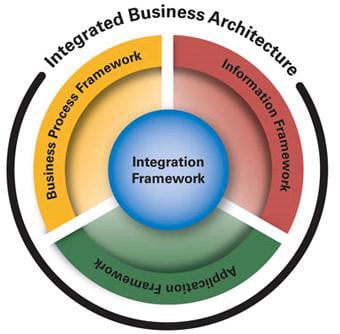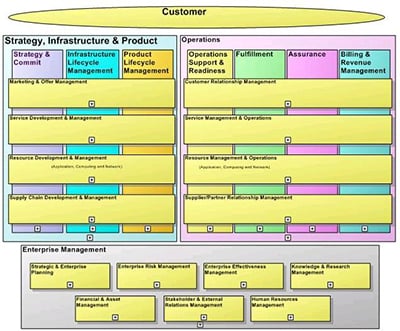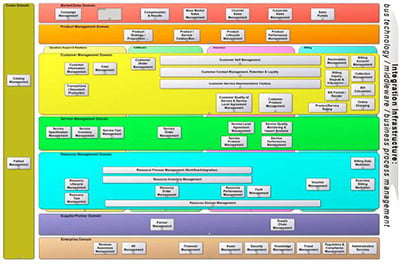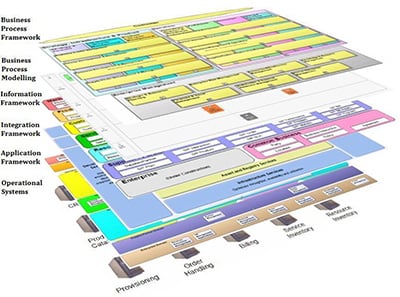The importance of adhering to standards within a software development environment has been recognised for some time now, however these activities have historically focused on IT standards such as the ANSI, ISO or WS-* families. Today we are seeing the evolution of standardisation; the adoption of the relevant IT standards is almost taken for granted, with the emphasis now being placed on the alignment with business standards and industry best practice.
In the IT landscape, standards have typically been designed to aid technical interoperability. Compliance with protocols (HTTP), messaging formats (XML), security constraints (WS-Security) and language specifications (ANSI) have all contributed towards greater integration across disparate systems and environments.
However with the emergence of business driven software development approaches, such as service oriented architecture (SOA) and business process management (BPM), we see an increasing need to align IT efforts with those of the business.
The benefits of successfully adopting SOA and BPM are now well documented. By placing business in the driving seat, we attempt to bridge the gap between business and IT communities that is often encountered on software development projects.
Through better alignment of IT capabilities with the needs of the business, we aim to derive a more agile IT environment, capable of reacting swiftly to support new business drivers, whilst minimising the impact of change. IT structure therefore needs to be aligned with business structure, and support the underlying processes and standards that are implemented by the business.
The emergence of independent industry bodies plays an increasingly important role in capturing and promoting the ideas and experience of industry thought leaders. Whilst many industries can now claim some form of guidance in this area, the telecommunications sector, primarily through the work of the TeleManagement Forum (TM Forum), offers one of the most mature and wide ranging frameworks.
The TMForum provides a set of integrated offerings under their Solution Frameworx initiative (formerly known as NGOSS), which offers an integrated business architecture supporting a standardised and widely accepted approach to creating industry aligned software solutions.
The Solution Frameworx provides an architectural blueprint, capturing the experience and best practices gleaned from the major players in the industry. This vision is accompanied by methodology for creating service oriented software solutions that adheres to the dynamic, loosely coupled and vendor neutral principles demanded by today’s communications service providers (CSPs).

Figure 1 - TMForum Solution Framework
The Solution Frameworx is an evolution of existing TMForum specifications, and includes the following components:-
- Business Process Framework - often referred to as eTOM (enhanced Telecom Operations Model), this defines a business architecture framework.
- Application Framework - the TAM (Telecom Applications Map), describes a common landscape used by service providers and their suppliers to describe the capabilities of underlying operational and business systems.
- Information Framework - the SID (the Shared Information / Data Model) provides a common reference model for enterprise information.
- Integration Framework - combines the three elements above to show how a service oriented approach can be taken to create agile and standardised software solutions.
Business Process Framework
The Business Process Framework presents a hierarchal decomposition of a CSP’s organisation. At the highest level it resembles a CBM (component business map), defining and describing the major business capabilities that a CSP must provide. These entities are iteratively refined through a series of levels, each of which provides a finer grained and more detailed description of the business activities.
Figure 2 - Business Process Framework - Level 1 View
(Click to view the diagram at its full size)
Whilst the framework does not provide detailed process execution models (i.e. it does not contain BPMN or BPEL content) it serves as blueprint for the construction of BPM solutions. The elements within the third or fourth level of decomposition typically represent re-usable elements of business functionality, and as such are ideal candidates for implementation as services in a SOA.
Application Framework
If the business process framework represents the ‘top down’ perspective, then the application framework provides the ‘bottom up’ view. It takes an IT-centric approach, describing the underlying operational systems that are necessary to support the business capabilities.
Figure 3 - Telecom Applications Map
(Click to view the diagram at its full size)
Often a mixture of packaged applications and bespoke development, this vision of the idealised IT landscape guides CSPs to structure their IT assets at the correct level of granularity and responsibility.
Information framework
The telecommunications world has changed rapidly over the past 20 years, and this rate of change shows little sign of abating. New products and services are constantly under development, and collaborations between suppliers and partners are leading to the creating of complex product bundles, reflecting the convergence in the industry.
In order to support these dynamic business interactions we need a dynamic information model. The SID provides an extendable information framework, defining over 1,000 business entities, each of which can be customised to meet the needs of the individual organisation. This canonical data model greatly enhances interoperability, both between systems within the TAM, and at a B2B (business to business) level.
Integration framework
The integration framework can be considered as the glue that binds the other three frameworks together. Whilst there are many elements within a SOA, it is perhaps the identification of service interfaces at the correct level of granularity that can have the greatest impact on the success of the solution.
Essentially it’s a case of ‘agility costs’; balancing the desire for reusable services against performance impact, is perhaps the most challenging aspect of SOA design. The framework introduces the concept of ‘business services’; coarse grained interfaces, defining the business functionality exposed by the underlying systems. They not only include a service interface, but also describe the context in which the service operates, and the qualities of service it provides.
The frameworks can effectively be layered, to provide a logical end to end standards aligned approach to constructing telecom architectures, as shown below in Figure 4.
Figure 4 - Standardised Layered Telecoms Architecture
(Click to view the diagram at its full size)
Implementing such standards and frameworks however can be a complex and time consuming task. In order to decrease the time to delivery of solutions, ISVs are now providing software accelerators which implement the frameworks, such as IBM's WebSphere Telecoms Content Pack (WTCP).
This provides a combination of architectural guidance and out-of-the-box assets, enabling development teams to focus on their business requirements and not the supporting software infrastructure.
Today's telecoms ecosystem contains a complex array of products and services, suppliers and partners, software and systems. CPSs operate in a rapidly evolving market, led by a combination of consumer demand and technological innovation.
In this environment the adoption of industry best practice can have a significant impact in reducing the time to market for new offerings, and hence differentiating yourself from the competition.















